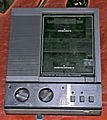Audio cassette facts for kids
An audio cassette is a small plastic case that holds a special magnetic tape. This tape can store music, voices, and other sounds. To listen to what's on a cassette, you need a cassette player or a cassette recorder. Inside the cassette, the tape is wound around two small wheels called reels.
How Cassettes Started
The standard audio cassette was invented in 1962 by a company called Philips. They gave it the name "Compact Cassette". When they first came out, the sound quality of cassettes and their players wasn't very good. But over time, the sound got much better.
During the 1970s, cassettes became a very popular way to listen to music and other sounds. People loved them because they were small and easy to carry around. Their popularity grew even more in the 1980s.
Why Cassettes Became Less Popular
As compact discs (CDs) became more popular, people started using cassettes less and less. CDs offered clearer sound and were easier to skip tracks on. In 2011, the Oxford English Dictionary even thought about removing the phrase "cassette tape" from a smaller version of its book, showing how much their use had declined.
Images for kids
-
The Sony Walkman
-
A typical portable desktop cassette recorder from RadioShack.
-
A dual cassette-based Panasonic answering machine.
-
A C2N Datassette recorder for Commodore computers.
See also
 In Spanish: Casete para niños
In Spanish: Casete para niños





















